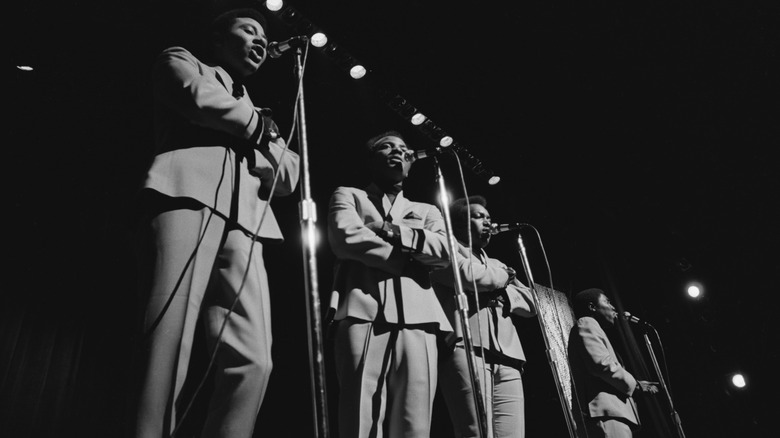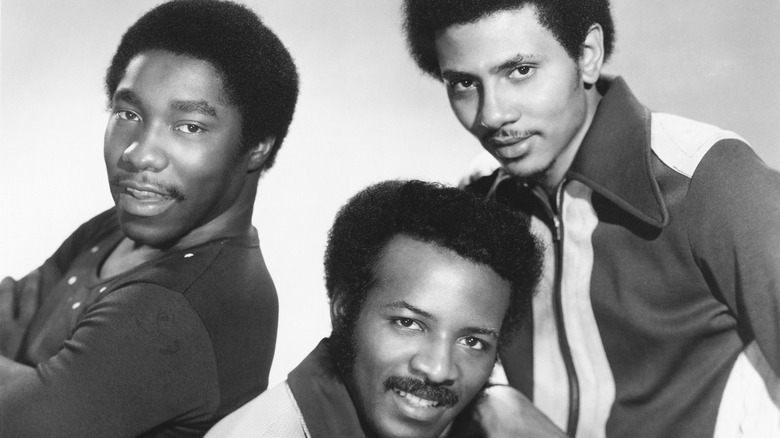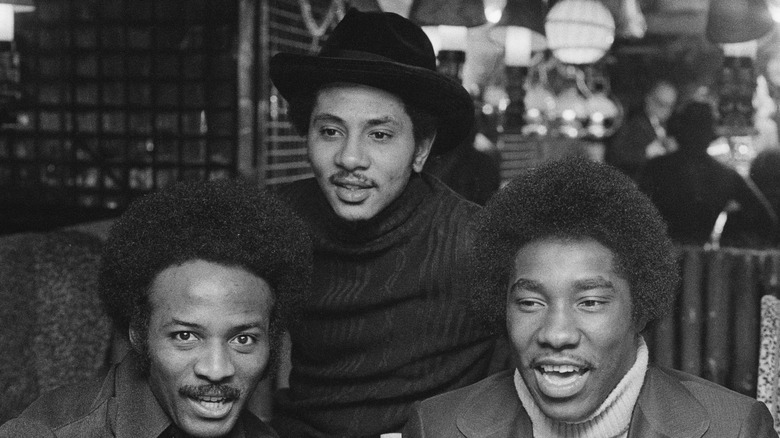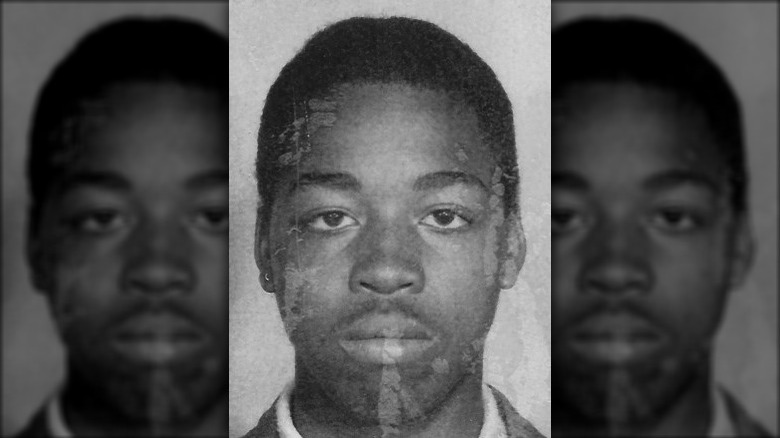The Untold Truth Of The O'Jays
Hailing from Canton, Ohio, The O'Jays formed in 1958 and originally consisted of childhood friends Eddie Levert and Walter Williams Sr. Eventually, they added McKinley High School classmates William Powell, Bobby Massey, and Bill Isles (via Black Past). According to All Music, the boys were inspired to form a musical group after seeing Frankie Lymon & the Teenagers perform. They first called themselves The Triumphs before settling on The Mascots. Britannica reports that as The Mascots, the group released their single "Miracles." Although the song did not bring them immediate fame, it did catch the attention of local disc jockey Eddie O'Jay (per Classic Bands).
O'Jay heavily promoted the single and gave the burgeoning group career advice. In honor of their new friend, The Mascots changed their name to the O'Jays in 1963 (via The O'Jays). That same year, The O'Jays signed to Imperial Records and released the song "Lonely Drifter." "Lipstick Traces" and "Stand in for Love" were then released in 1965 and 1966, respectively. In 1967, Isles decided to leave The O'Jays. He was not replaced. The group subsequently became a quartet and released their first album, "Comin' Thru."
The O'Jays and Philadelphia-style soul music
Per All Music, The O'Jays song "I'll Be Sweeter Tomorrow (Than I Was Today)" became their first single to enter the R&B charts. Despite their taste of success, the group's other music failed to make a splash. Though they considered quitting, Classic Bands writes that The O'Jays met producers Kenny Gamble and Leon Huff. Together, they recorded several singles that did moderately well. However, Gamble and Huff's label went under in 1971, leaving the future of The O'Jays up in the air. Adding to the stress, Massey decided to leave the group. As luck would have it, Gamble and Huff quickly went to another label, Philadelphia International Records (via Black Past). Now a trio, the label put The O'Jays to work.
According to Britannica, the O'Jays music with Philadelphia International Records had funk, rhythm, and "socially conscious" lyrics. Their song "Back Stabbers" would go on to be their biggest hit and topped both the R&B and Billboard Hot 100 Charts. It made The O'Jays bona fide stars, and the song helped create Philadelphia-style soul music. Although they never reached the success of "Back Stabbers," more popular singles followed between 1972 and 1978.
William Powell and Walter William Sr.'s health struggles
Tragedy struck The O'Jays when member William Powell was diagnosed with terminal cancer in 1975 (via Classic Bands). All Music reports that he continued to record with music as long as he could. However, the disease eventually forced Powell into retirement. According to the Cleveland Scene, Powell died in 1977 at the age of 35 from colon cancer. He would eventually be replaced by Sammy Strain, a veteran musician. Powell's family would later contend that he never got to benefit from the success of The O'Jays and that Philadelphia International Records had withheld funds from Powell's royalties after his death.
Powell would not be the only O'Jays member to suffer from ill health. In 1983, after feeling a numbness spread throughout his leg, Walter Williams Sr. was diagnosed with multiple sclerosis (per Cleveland). Though he was nearly 40 years old at the time, Reuters writes that he did not make his diagnoses public until 2010, when Williams' was in his late 60s. The doctors gave him 20 years to live, but he continued to perform and tour with The O'Jays.
The O'Jays in the '80s, '90s, and 2000s
Walter Williams' disease did not slow down The O'Jays. According to Classic Bands, the group continued to release various hits into the '80s and '90s. Per All Music, this includes 1987s "Lovin' You." When Sammy Strain left in 1993, he was replaced by Nathaniel Best. Once again, The O'Jays released hits that made it onto the R&B charts. By 1997, Best had been replaced by Eric Grant. Britannica writes that into the 2000s, The O'Jays continued recording and touring. They were even nominated for a Grammy for their 2001 album, "For the Love Of."
Due to their extensive career and accomplishments, The O'Jays have received various honors. Black Past reports that they were inducted into the Vocal Group Hall of Fame in 2004 and the Rock & Roll Hall of Fame in 2005. Moreover, they received a Lifetime Achievement Award from BET in 2009. After decades together, The O'Jays announced that their 2019 album "The Last Word" would be their final one (via Rated R&B).
The disappearance of Frank Little Jr.
According to the New York Post, Cleveland native Frank Little Jr. became a guitarist and songwriter for The O'Jays in the 1960s. Born in 1943, he was only with the band for a brief time. Despite this, he did manage to co-write a few songs with lead singer Eddie Levert, including "Do the Jerk" and "Pretty Words." When the group left Ohio for Los Angeles, Little joined them. However, he didn't stay long. Though he had a clear future in music, CNN writes that Little was in love with a woman in Cleveland and decided to go back home.
The O'Jays never heard from him again. Per News 5 Cleveland, not much is known about Little's life. It's believed he served in the U.S. Army for two years and was deployed to Vietnam during the Vietnam War. Little also had a son and daughter. He lived in Cleveland and was last seen sometime in the mid 1970s. After that, Little disappeared, and his fate would remain unknown until December 2021.
A 2021 DNA analysis reveals Frank Little's fate
In February 1982, a skull and a bag of human bones were found in the snow by employees at a machine shop in Twinsburg, Ohio (via Akron Beacon Journal). Though not all the bones were there, police determined that they belonged to an African American male who was 20 to 35 years old at the time of death. Despite the conclusion, there was no evidence, nothing at all, that could point to the remains' identity. CNN notes that the bones were already a few years old and had obvious signs of blunt force trauma. It became clear that this was a case of homicide. With nothing to go on, the case went cold. Decades later, DNA and genealogy would change all of that.
According to News 5 Cleveland, investigators reached out to the DNA Doe Project for help in October 2021. The nonprofit organization uses genealogy to aid in identification efforts. Research led them to Margaret O'Sullivan. She was asked if she had any missing relatives. Her reply? Her cousin Frank Little had gone missing years ago. A DNA sample from Little's brother proved that the remains did belong to the missing sibling. Per the New York Post, Eddie Levert expressed shock and sorrow at the discovery of his former bandmate's destiny. The investigation remains ongoing as authorities work on discovering what happened to Little and the identity of his killer.





